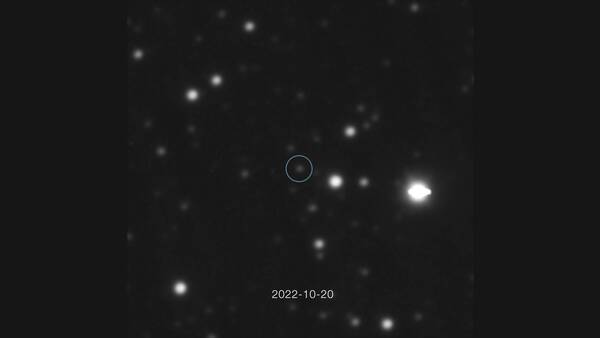Gammaglimt
Manage episode 359302713 series 1540312
En sekvens af billeder taget i optisk lys med ESO's Very Large Telescope, som viser gammaglimtet GRB 221009A ‘fade’ ud. Kredit: ESO/Malesani et al., The Stargate Collaboration.
A sequence of images, taken in optical light with ESO’s Very Large Telescope, shows the gamma-ray burst GRB 221009A fading away (click to animate). Credit: ESO/Malesani et al., The Stargate collaboration.
This sequence of images, taken in optical light with ESO’s Very Large Telescope, shows the gamma-ray burst GRB 221009A fading away. Gamma-ray bursts are the most luminous phenomena that we know of in the universe, and GRB 221009A is the brightest one yet as seen from Earth.
The burst was detected in October 2022 by several gamma-ray space telescopes, such as NASA's Swift and Fermi and ESA’s INTEGRAL. Then, a few hours after the initial detection, ESO’s X-shooter instrument at the VLT took a spectrum, which provided the first distance measurement to the explosion of approximately 2400 million light years. Thanks to this distance measurement, a team of astronomers led by Daniele Bjørn Malesani (Radboud University, the Netherlands; DAWN/Niels Bohr Institute, Denmark) ruled out an origin in the Milky Way, although the burst is still much closer to us than typical GRBs.
The distance also allowed the team to compute the intrinsic luminosity of the explosion. Despite being in our cosmic backyard, the burst is still intrinsically very luminous. It is in fact the most intense GRB for which we could measure its luminosity, and the brightest ever as seen from Earth in the 55 years since the first gamma-ray satellites were put in orbit. According to Malesani’s team, a burst so energetic and so close as this one should probably be observable once every 1000 years.
A team led by Andrew Levan (also Radboud University) observed this unique explosion with JWST at longer wavelengths. Combining the X-shooter spectrum with the JWST data allows for an in-depth investigation of the nature of this unique event.
Gamma-ray bursts can last from a few milliseconds up to hours (GRB 221009A lasted for about 10 hours). Once the initial bright flash of gamma-rays has died down, the afterglow shines at longer wavelengths like visible or infrared light, but it fades very quickly, so astronomers must react fast to observe these ephemeral sources.
2602 епізодів





